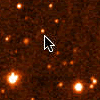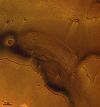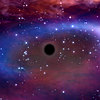Nearest, youngest star with planet nursery found
February 28:
Astronomers have discovered the nearest and youngest star with a
visible disk of dust that may be a nursery for planets. The dim
red dwarf star is a mere 33 light years away, close enough that
the Hubble Space Telescope or ground-based telescopes with adaptive
optics to sharpen the image should be able to see whether the dust
disk contains clumps of matter that might turn into planets.
 FULL STORY FULL STORY
 |
 |

|
 |
Cassini captures stunning view of Saturn
February 27:
Four months before its scheduled arrival at Saturn, the Cassini-Huygens spacecraft
sent its best colour postcard back to Earth of the ringed world. The spacecraft
is expected to send weekly postcards, as it gets closer to the ringed giant.
 FULL STORY FULL STORY
 |
 |

|
 |
Large planetoid found beyond Pluto
February 20:
A new object located by the Near Earth Asteroid Tracking (NEAT) survey
on February 17 and found in images by Mike Brown (Caltech), Chad Trujillo
(Gemini Observatory) and David Rabinowitz (Yale), may be the largest object
discovered in the solar system since Pluto in 1930.
 FULL STORY FULL STORY
 |
 |

|
 |
Mars Express images Kasei Vallis on Mars
February 18:
The European Space Agency's Mars Express spacecraft has imaged Kasei Vallis,
one of the largest outflow channels on Mars. The feature is believed to have been
created by glaciers or the bursting of subterranean lakes dammed by the glaciers.
 FULL STORY FULL STORY
 |
 |

|
 |
Largest mirror in space under development
February 18:
The European Space Agency's Herschel Space Observatory, designed to make observations
in the infrared and sub-milimetre band, is due to be launched in February 2007.
Engineers have recently completed a crucial phase of the project by manufacturing
its 3.5-metre main mirror from silicon carbide. Use of this revolutionary material
will result in a primary with a mass one fifth of a conventional mirror. Further
machining is required before it can be given its reflective coating.
 FULL STORY FULL STORY
 |
 |

|
 |
Giant black hole rips star apart
February 18:
A super-massive black hole has ripped apart a star and consumed a portion
of it, according to data from ESA's XMM-Newton and NASA's Chandra and X-ray
observatories. These results are the best evidence yet that such a phenomenon,
long predicted by theory, does actually happen.
 FULL STORY FULL STORY
 |
 |

|
 |



